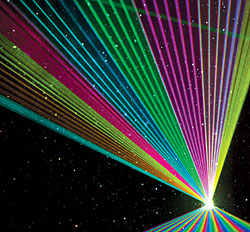Lasers, lasers everywhere! Make no mistake about it; laser therapy is a hot buzzword now in the healthcare industry. High tech help for pain is here to stay, so you must become educated about it to determine if laser is right for your practice.
Critical Questions
There are four critical questions to ask before selecting a laser. Answer these and you will be empowered to make a sound decision based on practice and patient needs:
- What types of musculoskeletal pain conditions are you treating?
- What type of training and support does the manufacturer provide?
- Who will be administering the laser therapy?
- What is your budget for purchasing a laser?
 Before diving into detail of the four critical questions it's important to understand laser technology and mechanisms of action before making a purchase. Laser therapy aims to photo-biostimulate chemically damaged cells via specific wavelengths of light. When cells are chemically damaged they stimulate the pain cycle. Laser excites the kinetic energy within cells by transmitting healing stimuli known as photons. The skin absorbs these photons via a photo-chemical effect, not photo-thermal; therefore it does not cause heat damage to the tissues. Once photons reach the cells of the body, they promote a cascade of cellular activities. Laser therapy light can ignite the production of enzymes, stimulate mitochondria, increase vasodilation and lymphatic drainage, ATP synthesis, and elevate collagen formation substances to prevent the formation of scar tissues. This is a critical step in reducing long term disabling chronic myofascial pain syndromes. Other formative cells are also positively influenced and immune enhancing effects are increased in the number of macrophages. Simply stated, your clients get out of pain faster and heal at the same time.
Before diving into detail of the four critical questions it's important to understand laser technology and mechanisms of action before making a purchase. Laser therapy aims to photo-biostimulate chemically damaged cells via specific wavelengths of light. When cells are chemically damaged they stimulate the pain cycle. Laser excites the kinetic energy within cells by transmitting healing stimuli known as photons. The skin absorbs these photons via a photo-chemical effect, not photo-thermal; therefore it does not cause heat damage to the tissues. Once photons reach the cells of the body, they promote a cascade of cellular activities. Laser therapy light can ignite the production of enzymes, stimulate mitochondria, increase vasodilation and lymphatic drainage, ATP synthesis, and elevate collagen formation substances to prevent the formation of scar tissues. This is a critical step in reducing long term disabling chronic myofascial pain syndromes. Other formative cells are also positively influenced and immune enhancing effects are increased in the number of macrophages. Simply stated, your clients get out of pain faster and heal at the same time.
There are different classes of laser therapy? Class is determined by power and potential to damage the eyes from light exposure. Class III lasers are up to 500 mW of power and Class IV is anything over 500 mW. Safety is of utmost importance with any Class III and IV laser, so eye protection is mandated by the FDA. The US Food and Drug Administration (FDA) approved the first low level Class III laser (LLLT) in 2002 and the first Class IV therapy laser in 2003. Treatment techniques, guidelines, price points, training, and ultimately condition specific results will depend on which class of laser you choose to purchase.
What types of musculoskeletal pain conditions are you treating?
Dosage of sufficient photonic laser energy (Joules) to target tissue is the single most important parameter for success in laser therapy. Dosage is determined by Joules per/cm2 and tissue depth.





